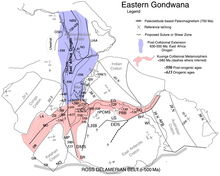Orogenesi Kuunga

L'orogenesi Kuunga (in lingua swahili: unire),[1] è un'orogenesi che si verificò nell'Africa sudorientale tra l'Ediacarano e il Cambriano. È composta da tre cinture orogenetiche separate (Damara, Zambesi e Lurio) che sono di poco più recenti dell'orogenesi est africana; l'orogenesi Kuunga documenta la collisione tra la parte nord e il sud della Gondwana, che attualmente corrispondono alla Terra della Regina Maud in Antartide e alla parte settentrionale del Mozambico in Africa.[2]
La denominazione fu proposta nel 1995 da J. G. Meert, R. van der Voo e S. Ayub.[3]
Note
- ^ Meert, 2003, p. 32.
- ^ Grantham Macey Horie Kawakami, 2013
- ^ J. G. Meert, R. van der Voo e S. Ayub, Paleomagnetic investigation of the Neoproterozoic Gagwe lavas and Mbozi complex, Tanzania and the assembly of Gondwana, in Precambrian Research, vol. 74, n. 4, 1995, pp. 225-244, DOI:10.1016/0301-9268(95)00012-T.
Bibliografia
- G. H. Grantham, P. H. Macey, K. Horie, T. Kawakami, M. Ishikawa, M. Satish-Kumar, N. Tsuchiya, P. Graser e S. Azevedo, Comparison of the metamorphic history of the Monapo Complex, northern Mozambique and Balchenfjella and Austhameren areas, Sør Rondane, Antarctica: Implications for the Kuunga Orogeny and the amalgamation of N and S. Gondwana (PDF), in Precambrian Research, vol. 234, 2013, pp. 85-135, DOI:10.1016/j.precamres.2012.11.012. URL consultato il 10 settembre 2017.
- J. G. Meert, A synopsis of events related to the assembly of eastern Gondwana (PDF), in Tectonophysics, vol. 362, n. 1, 2003, pp. 1–40, Bibcode:2003Tectp.362....1M, DOI:10.1016/S0040-1951(02)00629-7.
 Portale Geologia
Portale Geologia Portale Scienze della Terra
Portale Scienze della Terra









